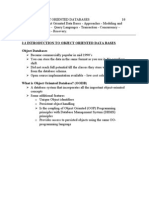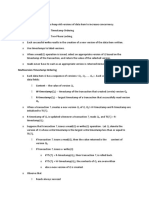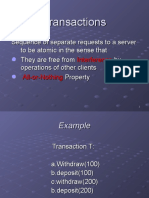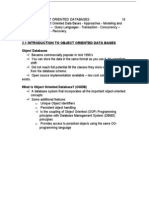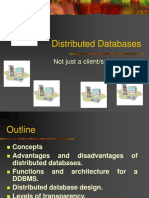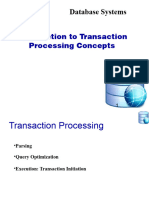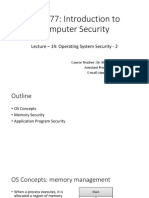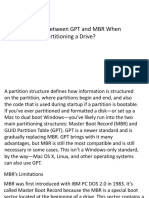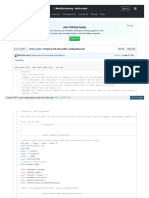Multi-Version Concurrency Control
Lecture 16: Multi-Version Concurrency Control
1 / 66
�Multi-Version Concurrency Control Recap
Recap
2 / 66
� Multi-Version Concurrency Control Recap
Optimistic Concurrency Control
• The DBMS creates a private workspace for each txn.
▶ Any object read is copied into workspace.
▶ Modifications are applied to workspace.
• When a txn commits, the DBMS compares workspace write set to see whether it
conflicts with other txns.
• If there are no conflicts, the write set is installed into the global database.
3 / 66
� Multi-Version Concurrency Control Recap
OCC Phases
• Phase 1 – Read:
▶ Track the read/write sets of txns and store their writes in a private workspace.
• Phase 2 – Validation:
▶ When a txn commits, check whether it conflicts with other txns.
• Phase 3 – Write:
▶ If validation succeeds, apply private changes to database. Otherwise abort and restart the
txn.
4 / 66
� Multi-Version Concurrency Control Recap
Today’s Agenda
• Multi-Version Concurrency Control
• Design Decisions
▶ Concurrency Control Protocol
▶ Version Storage
▶ Garbage Collection
▶ Index Management
5 / 66
� Multi-Version Concurrency Control Multi-Version Concurrency Control
Multi-Version Concurrency Control
6 / 66
� Multi-Version Concurrency Control Multi-Version Concurrency Control
Multi-Version Concurrency Control
• The DBMS maintains multiple physical versions of a single logical object in the
database:
▶ When a txn writes to an object, the DBMS creates a new version of that object (instead of
private workspace in OCC)
▶ When a txn reads an object, it reads the newest version that existed when the txn started.
7 / 66
� Multi-Version Concurrency Control Multi-Version Concurrency Control
MVCC HISTORY
• Protocol was first proposed in 1978 MIT PhD dissertation.
• First implementations was Rdb/VMS and InterBase at DEC in early 1980s.
▶ Both were by Jim Starkey, co-founder of NuoDB.
▶ DEC Rdb/VMS is now "Oracle Rdb"
▶ InterBase was open-sourced as Firebird.
8 / 66
� Multi-Version Concurrency Control Multi-Version Concurrency Control
Multi-Version Concurrency Control
• Writers don’t block readers. Readers don’t block writers.
• Read-only txns can read a consistent snapshot without acquiring locks.
▶ Use timestamps to determine visibility.
• Easily support time-travel queries.
9 / 66
� Multi-Version Concurrency Control Multi-Version Concurrency Control
MVCC – Example 1
10 / 66
� Multi-Version Concurrency Control Multi-Version Concurrency Control
MVCC – Example 1
11 / 66
� Multi-Version Concurrency Control Multi-Version Concurrency Control
MVCC – Example 1
12 / 66
� Multi-Version Concurrency Control Multi-Version Concurrency Control
MVCC – Example 1
13 / 66
� Multi-Version Concurrency Control Multi-Version Concurrency Control
MVCC – Example 1
14 / 66
� Multi-Version Concurrency Control Multi-Version Concurrency Control
MVCC – Example 2
15 / 66
� Multi-Version Concurrency Control Multi-Version Concurrency Control
MVCC – Example 2
16 / 66
� Multi-Version Concurrency Control Multi-Version Concurrency Control
MVCC – Example 2
17 / 66
� Multi-Version Concurrency Control Multi-Version Concurrency Control
MVCC – Example 2
18 / 66
� Multi-Version Concurrency Control Multi-Version Concurrency Control
MVCC – Example 2
19 / 66
� Multi-Version Concurrency Control Multi-Version Concurrency Control
MVCC – Example 2
20 / 66
� Multi-Version Concurrency Control Multi-Version Concurrency Control
MVCC – Example 2
21 / 66
� Multi-Version Concurrency Control Multi-Version Concurrency Control
Multi-Version Concurrency Control
• MVCC is more than just a Concurrency Control protocol.
• It completely affects how the DBMS manages transactions and the database.
• Examples: Oracle, SAP HANA, PostgreSQL, CockroachDB
22 / 66
� Multi-Version Concurrency Control Multi-Version Concurrency Control
MVCC Design Decisions
• Concurrency Control Protocol
• Version Storage
• Garbage Collection
• Index Management
23 / 66
� Multi-Version Concurrency Control Concurrency Control Protocol
Concurrency Control Protocol
24 / 66
� Multi-Version Concurrency Control Concurrency Control Protocol
Concurrency Control Protocol
• Approach 1: Timestamp Ordering
▶ Assign txns timestamps that determine serial order.
• Approach 2: Optimistic Concurrency Control
▶ Three-phase protocol from last class.
▶ Use private workspace for new versions.
• Approach 3: Two-Phase Locking
▶ Txns acquire appropriate lock on physical version before they can read/write a logical
tuple.
25 / 66
�Multi-Version Concurrency Control Version Storage
Version Storage
26 / 66
� Multi-Version Concurrency Control Version Storage
Version Storage
• The DBMS uses the tuples’ pointer field to create a version chain per logical tuple.
▶ This allows the DBMS to find the version that is visible to a particular txn at runtime.
▶ Indexes always point to the head of the chain.
• Different storage schemes determine where/what to store for each version.
27 / 66
� Multi-Version Concurrency Control Version Storage
Version Storage
• Approach 1: Append-Only Storage
▶ New versions are appended to the same table space.
• Approach 2: Time-Travel Storage
▶ Old versions are copied to separate table space.
• Approach 3: Delta Storage
▶ The original values of the modified attributes are copied into a separate delta record space.
28 / 66
� Multi-Version Concurrency Control Version Storage
Append-Only Storage
• All of the physical versions of a logical tuple are stored in the same table space. The
versions are mixed together.
• On every update, append a new version of the tuple into an empty space in the table.
29 / 66
� Multi-Version Concurrency Control Version Storage
Append-Only Storage
• All of the physical versions of a logical tuple are stored in the same table space. The
versions are mixed together.
• On every update, append a new version of the tuple into an empty space in the table.
30 / 66
� Multi-Version Concurrency Control Version Storage
Append-Only Storage
• All of the physical versions of a logical tuple are stored in the same table space. The
versions are mixed together.
• On every update, append a new version of the tuple into an empty space in the table.
31 / 66
� Multi-Version Concurrency Control Version Storage
Version Chain Ordering
• Approach 1: Oldest-to-Newest (O2N)
▶ Just append new version to end of the chain.
▶ Have to traverse chain on look-ups.
• Approach 2: Newest-to-Oldest (N2O)
▶ Have to update index pointers for every new version.
▶ Don’t have to traverse chain on look ups.
32 / 66
� Multi-Version Concurrency Control Version Storage
Time-Travel Storage
• On every update, copy the current version to the time-travel table. Update pointers.
• Overwrite master version in the main table. Update pointers.
33 / 66
� Multi-Version Concurrency Control Version Storage
Time-Travel Storage
• On every update, copy the current version to the time-travel table. Update pointers.
• Overwrite master version in the main table. Update pointers.
34 / 66
� Multi-Version Concurrency Control Version Storage
Time-Travel Storage
• On every update, copy the current version to the time-travel table. Update pointers.
• Overwrite master version in the main table. Update pointers.
35 / 66
� Multi-Version Concurrency Control Version Storage
Time-Travel Storage
• On every update, copy the current version to the time-travel table. Update pointers.
• Overwrite master version in the main table. Update pointers.
36 / 66
� Multi-Version Concurrency Control Version Storage
Delta Storage
• On every update, copy only the values that were modified to the delta storage and
overwrite the master version.
• Txns can recreate old versions by applying the delta in reverse order.
37 / 66
� Multi-Version Concurrency Control Version Storage
Delta Storage
• On every update, copy only the values that were modified to the delta storage and
overwrite the master version.
• Txns can recreate old versions by applying the delta in reverse order.
38 / 66
� Multi-Version Concurrency Control Version Storage
Delta Storage
• On every update, copy only the values that were modified to the delta storage and
overwrite the master version.
• Txns can recreate old versions by applying the delta in reverse order.
39 / 66
� Multi-Version Concurrency Control Version Storage
Delta Storage
• On every update, copy only the values that were modified to the delta storage and
overwrite the master version.
• Txns can recreate old versions by applying the delta in reverse order.
40 / 66
�Multi-Version Concurrency Control Garbage Collection
Garbage Collection
41 / 66
� Multi-Version Concurrency Control Garbage Collection
Garbage Collection
• The DBMS needs to remove reclaimable physical versions from the database over
time.
▶ No active txn in the DBMS can see that version (SI).
▶ The version was created by an aborted txn.
• Two additional design decisions:
▶ How to look for expired versions?
▶ How to decide when it is safe to reclaim memory?
42 / 66
� Multi-Version Concurrency Control Garbage Collection
Garbage Collection
• Approach 1: Tuple-level
▶ Find old versions by examining tuples directly.
▶ Background Vacuuming vs. Cooperative Cleaning
• Approach 2: Transaction-level
▶ Txns keep track of their old versions so the DBMS does not have to scan tuples to
determine visibility.
43 / 66
� Multi-Version Concurrency Control Garbage Collection
Tuple-level GC
• Background Vacuuming:
• Separate thread(s) periodically scan the table and look for reclaimable versions.
• Works with any storage.
44 / 66
� Multi-Version Concurrency Control Garbage Collection
Tuple-level GC
45 / 66
� Multi-Version Concurrency Control Garbage Collection
Tuple-level GC
46 / 66
� Multi-Version Concurrency Control Garbage Collection
Tuple-level GC
47 / 66
� Multi-Version Concurrency Control Garbage Collection
Tuple-level GC
48 / 66
� Multi-Version Concurrency Control Garbage Collection
Tuple-level GC
• Cooperative Cleaning:
• Worker threads identify reclaimable versions as they traverse version chain.
• Only works with O2N.
49 / 66
� Multi-Version Concurrency Control Garbage Collection
Tuple-level GC
50 / 66
� Multi-Version Concurrency Control Garbage Collection
Tuple-level GC
51 / 66
� Multi-Version Concurrency Control Garbage Collection
Tuple-level GC
52 / 66
� Multi-Version Concurrency Control Garbage Collection
Tuple-level GC
53 / 66
� Multi-Version Concurrency Control Garbage Collection
Transaction-level GC
• Each txn keeps track of its read/write set.
• The DBMS determines when all versions created by a finished txn are no longer visible.
54 / 66
�Multi-Version Concurrency Control Index Management
Index Management
55 / 66
� Multi-Version Concurrency Control Index Management
Index Management
• Primary key indexes point to version chain head.
▶ How often the DBMS has to update the pkey index depends on whether the system
creates new versions when a tuple is updated.
▶ If a txn updates a tuple’s pkey attribute(s), then this is treated as an DELETE followed by
an INSERT.
• Secondary indexes are more complicated. . .
56 / 66
� Multi-Version Concurrency Control Index Management
Secondary Indexes
• Approach 1: Physical Pointers
▶ Use the physical address to the version chain head.
• Approach 2: Logical Pointers
▶ Use a fixed identifier per tuple that does not change.
▶ Requires an extra indirection layer.
▶ Primary Key vs. Tuple Id
57 / 66
� Multi-Version Concurrency Control Index Management
Physical Pointers
58 / 66
� Multi-Version Concurrency Control Index Management
Physical Pointers
59 / 66
� Multi-Version Concurrency Control Index Management
Physical Pointers
60 / 66
� Multi-Version Concurrency Control Index Management
Physical Pointers
61 / 66
� Multi-Version Concurrency Control Index Management
Logical Pointers
62 / 66
� Multi-Version Concurrency Control Index Management
Logical Pointers
63 / 66
� Multi-Version Concurrency Control Index Management
MVCC Implementations
DBMS Protocol Version Storage Garbage Collection Indexes
Oracle MV2PL Delta Vacuum Logical
Postgres MV-2PL/MV-TO Append-Only Vacuum Physical
MySQL-InnoDB MV-2PL Delta Vacuum Logical
HYRISE MV-OCC Append-Only – Physical
Hekaton MV-OCC Append-Only Cooperative Physical
MemSQL MV-OCC Append-Only Vacuum Physical
SAP HANA MV-2PL Time-travel Hybrid Logical
NuoDB MV-2PL Append-Only Vacuum Logical
HyPer MV-OCC Delta Txn-level Logical
64 / 66
� Multi-Version Concurrency Control Index Management
Conclusion
• MVCC is the widely used scheme in DBMSs.
• Even systems that do not support multi-statement txns (e.g., NoSQL) use it.
65 / 66
� Multi-Version Concurrency Control Index Management
Next Class
• Advanced topics in Concurrency Control
66 / 66











